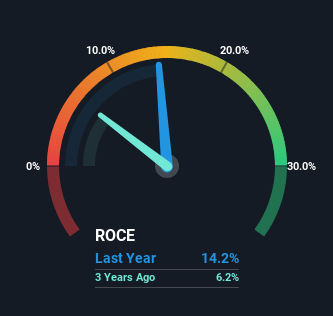The Return Trends At ORIOR (VTX:ORON) Look Promising
If we want to find a stock that could multiply over the long term, what are the underlying trends we should look for? One common approach is to try and find a company with returns on capital employed (ROCE) that are increasing, in conjunction with a growing amount of capital employed. This shows us that it's a compounding machine, able to continually reinvest its earnings back into the business and generate higher returns. With that in mind, we've noticed some promising trends at ORIOR (VTX:ORON) so let's look a bit deeper.
Understanding Return On Capital Employed (ROCE)
For those that aren't sure what ROCE is, it measures the amount of pre-tax profits a company can generate from the capital employed in its business. The formula for this calculation on ORIOR is:
Return on Capital Employed = Earnings Before Interest and Tax (EBIT) ÷ (Total Assets - Current Liabilities)
0.14 = CHF31m ÷ (CHF368m - CHF151m) (Based on the trailing twelve months to December 2023).
Thus, ORIOR has an ROCE of 14%. In absolute terms, that's a pretty normal return, and it's somewhat close to the Food industry average of 13%.
Check out our latest analysis for ORIOR
Above you can see how the current ROCE for ORIOR compares to its prior returns on capital, but there's only so much you can tell from the past. If you're interested, you can view the analysts predictions in our free analyst report for ORIOR .
What The Trend Of ROCE Can Tell Us
We're pretty happy with how the ROCE has been trending at ORIOR. The figures show that over the last five years, returns on capital have grown by 21%. That's a very favorable trend because this means that the company is earning more per dollar of capital that's being employed. In regards to capital employed, ORIOR appears to been achieving more with less, since the business is using 28% less capital to run its operation. ORIOR may be selling some assets so it's worth investigating if the business has plans for future investments to increase returns further still.
On a side note, we noticed that the improvement in ROCE appears to be partly fueled by an increase in current liabilities. The current liabilities has increased to 41% of total assets, so the business is now more funded by the likes of its suppliers or short-term creditors. Given it's pretty high ratio, we'd remind investors that having current liabilities at those levels can bring about some risks in certain businesses.
The Bottom Line On ORIOR's ROCE
From what we've seen above, ORIOR has managed to increase it's returns on capital all the while reducing it's capital base. Since the total return from the stock has been almost flat over the last five years, there might be an opportunity here if the valuation looks good. With that in mind, we believe the promising trends warrant this stock for further investigation.
If you want to continue researching ORIOR, you might be interested to know about the 1 warning sign that our analysis has discovered.
While ORIOR isn't earning the highest return, check out this free list of companies that are earning high returns on equity with solid balance sheets.
Have feedback on this article? Concerned about the content? Get in touch with us directly. Alternatively, email editorial-team (at) simplywallst.com.
This article by Simply Wall St is general in nature. We provide commentary based on historical data and analyst forecasts only using an unbiased methodology and our articles are not intended to be financial advice. It does not constitute a recommendation to buy or sell any stock, and does not take account of your objectives, or your financial situation. We aim to bring you long-term focused analysis driven by fundamental data. Note that our analysis may not factor in the latest price-sensitive company announcements or qualitative material. Simply Wall St has no position in any stocks mentioned.

